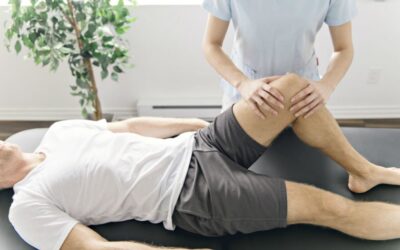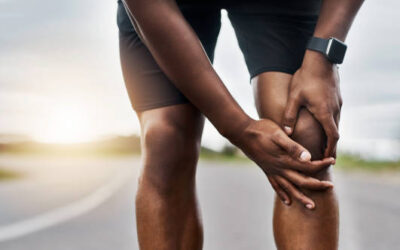You might have heard it from your primary care physician and it’s no surprise that you’re going to hear it again from me. If you have knee pain, one way to decrease that pain is to take some pressure off of the knee joint.
How do you do that? It sounds simple and I am sure you have heard it before, so it comes as no surprise that the number one way to decrease pain in your knees is to lose weight.
But, did you know that for every 1 pound of bodyweight you have, there are 4 pounds of force going through the knee?
And I am going to stop you right there because you are probably thinking one of two things…
First, you might be thinking “Okay yeah but how am I supposed to lose weight if it hurts my knees to exercise?” I’ll get to that in just a second…
The second thing you might be thinking is “Kick rocks, dude. I’ll just take some ibuprofen and call it good.”
But if you are to the point where your knee pain is so severe that it is affecting your lifestyle and daily activities and you are not fond of compromising your liver, kidneys and other organs with pain meds, hear me out.
Knee pain can make it tough to exercise especially if you are overweight. However, it’s important to keep moving because exercise is key to improving overall knee function (as well as other joints), decreasing pain, and losing extra pounds. Excess weight puts more pressure on the joints which makes the pain worse.
Exercise is one of the best remedies for arthritic knee pain. I have said it multiple times: motion is lotion! Movement is medicine! And exercise doesn’t just help the arthritic knee. It also helps with other types of knee pain. Exercise has a host of benefits such as alleviating swelling and stiffness, improving the range of motion in the joint, and strengthening the muscles around the knee.
It also goes without saying that exercise can help you lose weight. That is the main reason most people do it. Though there are an exceptional few who do it for the endorphins which is a secondary effect that exercise can have on the body in addition to weight loss. A two for one if you will. My kind of bargain!
Research consistently shows that physical activity for knee pain often results in better outcomes than medications, injections, and surgery. Research studies also recommend that it be the first-line treatment for knee pain because of the multitude of advantages and benefits.
You might be wondering how exercise could be more effective at providing better outcomes than medication, injections, or surgery.
Let me explain…
Extra weight takes a toll on the joints. Reducing the weight load on your knee can ease pain. Strengthening the muscles around the knee also takes pressure off of the knee. For example, strong quadriceps can offset the shock-absorbing role usually played by the meniscus or cartilage in the knee.
Not to sound like a broken record but exercise, specifically strength training, helps strengthen the muscles surrounding the knee joint. The more physical activity you do, the more likely you are to lose weight. That combination (muscle strength + weight loss) is the recipe for success when it comes to decreasing and even eliminating knee pain.
Here’s a quick anatomy lesson…
The quadriceps are the main muscles that support the knees. Weak quads can lead to knee instability, which increases wear and tear. So, strong quads play an important role in knee function and pain rehabilitation.
Hamstrings are another important muscle group supporting the knee. Each person’s pain level, fitness level, and underlying medical condition are different, so there is no one-size-fits-all list of best exercises for knee pain.
But the main take-away is that exercise of any kind can help increase strength and decrease weight thus relieving pressure and pain in the knee joint.
If you have followed along in other articles you will know that I am a big advocate of meeting yourself at your own starting line. It is important to understand that everyone has to start somewhere which might mean starting with low impact exercises to get in a routine.
Low-impact exercises that help stretch and strengthen the knee and supporting muscles (especially quadriceps) are generally best for people with knee pain. Low impact exercises to consider include:
- Walking: This lubricates the joints, burns calories, and aids in weight loss. Walking also increases blood flow to tight muscles and helps strengthen the muscles surrounding your knee. Longer, slower walks are more knee-pain friendly.
- Cycling: Biking is a safe workout for people with knee pain. Cycling provides aerobic as well as strengthening benefits. It promotes range of motion and targets the quadricep muscles. Peddling also strengthens the hamstrings and glutes.
- Water exercises: Swimming and water aerobics are go-to exercises that can help strengthen knee muscles. The buoyancy of the water allows you to exercise without putting pressure on your joints.
- Strength training: This is critical to improving your knee function. Weight machines—such as the seated knee extension—help strengthen the muscles. You can also use bodyweight exercises in place of weight machines. Straight leg raises and squats – even modified squats – are some good exercises for knees.
- Stretching: Tight knee and leg muscles add to pain, so it’s critical not to skip stretching after exercising. Stretches that help the knee and surrounding muscles include knee quadriceps stretch and standing hamstring stretch.
- Yoga and Pilates have been shown to be beneficial in increasing overall knee strength without overextending the joints.
Whatever modality you choose, just know that every step you take is a step that gets you closer to your goal of losing weight to reduce knee pain. If you don’t know where to start, no problem. Start by giving me a call or sending me an email. I can help structure your exercise program around your current knee pain so you can lose weight, get stronger and feel better!
If you are curious about knee pain in general, I have a ton of resources for you to check out.
Click here to download my Knee Pain Guide
If you want some more light reading you can check out some other articles I have written about knee pain here…
5 Reasons Your Knee Is Still Hurting After Surgery
Exercises To Avoid At The Gym When Experiencing Knee Pain




